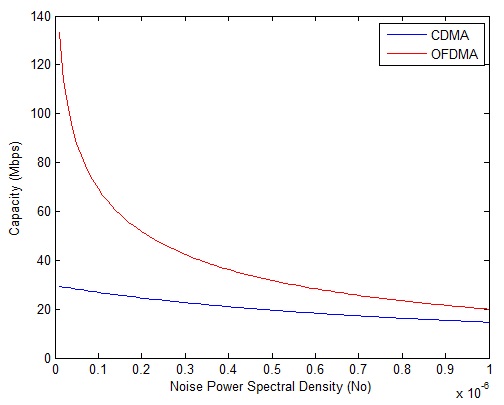We have previously discussed Shannon Capacity of CDMA and OFMDA, here we will discuss it again in a bit more detail. Let us assume that we have 20 MHz bandwidth for both the systems which is divided amongst 20 users. For OFDMA we assume that each user gets 1 MHz bandwidth and there are no guard bands or pilot carriers. For CDMA we assume that each user utilizes full 20 MHz bandwidth. We can say that for OFDMA each user has a dedicated channel whereas for CDMA the channel is shared between 20 simultaneous users.
We know that Shannon Capacity is given as
C=B*log2(1+SNR)
or in the case of CDMA
C=B*log2(1+SINR)
where ‘B’ is the bandwidth and SINR is the signal to noise plus interference ratio. For OFDMA the SNR is given as
SNR=Pu/(B*No)
where ‘Pu’ is the signal power of a single user and ‘No’ is the Noise Power Spectral Density. For CDMA the calculation of SINR is a bit more complicated as we have to take into account the Multiple Access Interference. If the total number of users is ‘u’ the SINR is calculated as
SINR=Pu/(B*No+(u-1)*Pu)
The code given below plots the capacity of CDMA and OFDMA as a function of Noise Power Spectral Density ‘No’.
%%%%%%%%%%%%%%%%%%%%%%%%%%%%%%%%%%%%%%%%%%%%%%%%%%%
% CAPACITY OF CDMA and OFDMA
% u - Number of users
% Pu - Power of a single user
% No - Noise Power Spectral Density
%
% Copyright RAYmaps (www.raymaps.com)
%%%%%%%%%%%%%%%%%%%%%%%%%%%%%%%%%%%%%%%%%%%%%%%%%%%
clear all
close all
u=20;
Pu=1;
No=1e-8:1e-8:1e-6;
B=20e6;
C_CDMA=u*B*log2(1+Pu./(B*No+(u-1)*Pu));
B=1e6;
C_OFDMA=u*B*log2(1+Pu./(B*No));
plot(No,C_CDMA/1e6);hold on
plot(No,C_OFDMA/1e6,'r');hold off
xlabel('Noise Power Spectral Density (No)')
ylabel('Capacity (Mbps)')
legend('CDMA','OFDMA')
%%%%%%%%%%%%%%%%%%%%%%%%%%%%%%%%%%%%%%%%%%%%%%%%%%%

We see that the capacity of OFDMA is much more sensitive to noise than CDMA. Within the low noise region the capacity of OFDMA is much better than CDMA but as the noise increases the capacity of the two schemes converges. In fact it was seen that as the noise PSD is further increased the two curves completely overlap each other. Therefore it can be concluded that OFDMA is the preferred technique when we are operating in the high SNR regime.
Author: Yasir
More than 20 years of experience in various organizations in Pakistan, the USA, and Europe. Worked with the Mobile and Portable Radio Group (MPRG) of Virginia Tech and Qualcomm USA and was one of the first researchers to propose Space Time Block Codes for eight transmit antennas. Have publsihed a book “Recipes for Communication and Signal Processing” through Springer Nature.